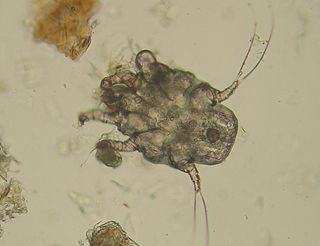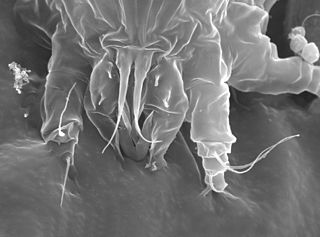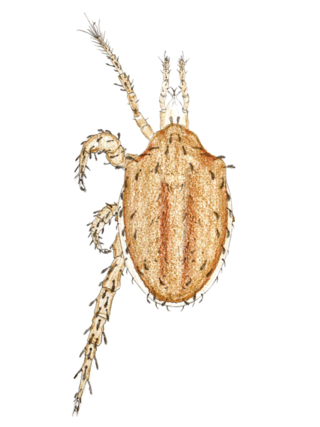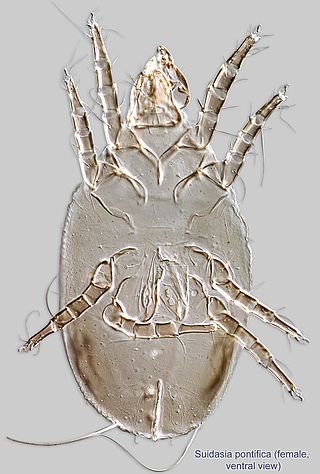Hypoaspis is a genus of mites in the family Laelapidae.

The Acaridae are a family of mites in order Sarcoptiformes.

Astigmatina is a clade of mites in the superorder Acariformes. Astigmata has been ranked as an order or suborder in the past, but was lowered to the unranked clade Astigmatina of the clade Desmonomatides in the order Sarcoptiformes. Astigmatina is now made up of the two groups Acaridia and Psoroptidia, which have been suborders of the order Astigmata in the past. Astigmatina contains about 10 superfamilies and 76 families under Acaridia and Psoroptidia.

Eriophyoidea are a superfamily of herbivorous mites. All post-embryonic instars lack the third and fourth pairs of legs, and the respiratory system is also absent.
The Raphignathoidea is a superfamily of the Acari (mite) order Trombidiformes, comprising 1087 species in 62 genera and 12 families.

Trombidiidae, also known as red velvet mites, true velvet mites, or rain bugs, are small arachnids found in plant litter and are known for their bright red color.

Trombiculidae, commonly referred to in North America as chiggers and in Britain as harvest mites, but also known as berry bugs, bush-mites, red bugs or scrub-itch mites, are a family of mites. Chiggers are often confused with jiggers – a type of flea. Several species of Trombiculidae in their larva stage bite their animal or human host and by embedding their mouthparts into the skin cause "intense irritation" or "a wheal, usually with severe itching and dermatitis".

Lorryia formosa, commonly known as the yellow mite or the citrus yellow mite, is a species of acariform mite. They are in the subfamily Tydeinae of the family Tydeidae. Commonly found on the foliage of citrus trees around the world, Lorryia formosa also associates with a variety of other plant types. The life cycle includes six discrete stages of development, and the lifespan averages about 37 days. The females of the species use an asexual form of reproduction where the growth and development of embryos occurs without fertilization by a male, a process called thelytoky.

Parasitengona is a group of mites, variously ranked as a hyporder or a cohort, between the taxonomic ranks of order and family.

The Laelapidae are a family of mites in the order Mesostigmata. The family is also referred to in the literature as Laelaptidae, which may be the correct spelling.
Cosmoglyphus is a genus of mites in the family Acaridae.

Macrochelidae is a family of mites in the order Mesostigmata.
Ascidae is a family of mites in the order Mesostigmata.

Brevipalpus phoenicis, also known as the false spider mite, red and black flat mite, and in Australia as the passionvine mite, is a species of mite in the family Tenuipalpidae. This species occurs globally, and is a serious pest to such crops as citrus, tea, papaya, guava and coffee, and can heavily damage numerous other crops. They are unique in having haploid females, a condition caused by a bacterium that change haploid males into females.
Phenopelopidae is a family of oribatid mites in the order Sarcoptiformes. As of 2018, there were 4 genera and 106 species known in this family.

Halacaridae is a family of meiobenthic mites found in marine, brackish, and freshwater habitats around the world. It includes more than 1100 described species belonging to 64 genera It is the largest marine radiation of arachnids.

Roubikia is a genus of bee-associated mites occurring in the neotropics. They are mutualists or commensals, and feed on fatty acids from floral oils and most likely on fungi. The type species is Chaetodactylus panamensis.
Tyrophagus longior is a mite in the family Acaridae.
Aleuroglyphus ovatus, commonly known as brown-legged mite or brownlegged grain mite, is a species of mite in the family Acaridae. It is a cosmopolitan pest of grain.

Suidasia is a genus of mites in the family Suidasiidae and clade Astigmatina.













